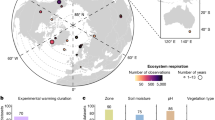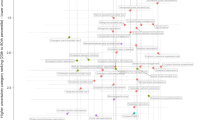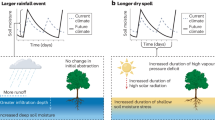Abstract
The environmental effects of agriculture and food are much discussed, with competing claims concerning the impacts of conventional and organic farming. Life cycle assessment (LCA) is the method most widely used to assess environmental impacts of agricultural products. Current LCA methodology and studies tend to favour high-input intensive agricultural systems and misrepresent less intensive agroecological systems such as organic agriculture. LCA assesses agroecological systems inadequately for three reasons: (1) a lack of operational indicators for three key environmental issues; (2) a narrow perspective on functions of agricultural systems; and (3) inconsistent modelling of indirect effects.
This is a preview of subscription content, access via your institution
Access options
Access Nature and 54 other Nature Portfolio journals
Get Nature+, our best-value online-access subscription
$29.99 / 30 days
cancel any time
Subscribe to this journal
Receive 12 digital issues and online access to articles
$119.00 per year
only $9.92 per issue
Buy this article
- Purchase on Springer Link
- Instant access to full article PDF
Prices may be subject to local taxes which are calculated during checkout


Jacques Baudry (a); Valérie Viaud (b)

Similar content being viewed by others
References
Willett, W. et al. Food in the Anthropocene: the EAT–Lancet Commission on healthy diets from sustainable food systems. Lancet 393, 447–492 (2019).
Eyhorn, J. et al. Sustainability in global agriculture driven by organic farming. Nat. Sustain. 2, 253–255 (2019).
European Commission - Joint Research Centre International Reference Life Cycle Data System (ILCD) Handbook - General guide for Life Cycle Assessment - Detailed Guidance (Publications Office of the European Union, 2010).
Bauman, H. & Tillman A. M. The Hitchhiker’s Guide to LCA (Studentlitteratur AB, 2004).
The Environmental Footprint Pilots (European Commission, accessed 24 October 2019); https://go.nature.com/2SQv2fo
Clark, M. & Tilman, D. Comparative analysis of environmental impacts of agricultural production systems, agricultural input efficiency, and food choice. Environ. Res. Lett. 12, 064016 (2017).
Huang, J. et al. Comparative review of multifunctionality and ecosystem services in sustainable agriculture. J. Environ. Manage. 149, 138–147 (2015).
Burkhard, B., Crossman, N., Nedkov, S., Petz, K. & Alkemade, R. Mapping and modelling ecosystem services for science, policy and practice. Ecosyst. Serv. 4, 1–3 (2013).
Agroecological and Other Innovative Approaches for Sustainable Agriculture and Food Systems that Enhance Food Security and Nutrition. A Report by the High Level Panel of Experts on Food Security and Nutrition of the Committee on World Food Security (HLPE, 2019).
Paull, J. From France to the world: The International Federation of Organic Agriculture Movements (IFOAM). J. Soc. Res. Policy 1, 93–102 (2010).
Basset-Mens, C., Ledgard, S. & Boyes, M. Eco-efficiency of intensification scenarios for milk production in New Zealand. Ecol. Econ. 68, 1615–1625 (2009).
Haines-Young, R., Potschin-Young, M. & Czúcz, B. Report on the Use of CICES to Identify and Characterise the Biophysical, Social and Monetary Dimensions of ES Assessments Deliverable D4.2, EU Horizon 2020 ESMERALDA Project (European Commission, 2018).
Tuomisto, H. L., Hodge, I. D., Riordan, P. & Macdonald, D. W. Does organic farming reduce environmental impacts? – A meta-analysis of European research. J. Environ. Manage. 112, 309–320 (2012).
Meier, M. S. et al. Environmental impacts of organic and conventional agricultural products – are differences captured by life cycle assessment? J. Environ. Manage. 149, 193–207 (2015).
Schleenbecker, R. & Hamm, U. Consumers’ perception of organic product characteristics. A review. Appetite 71, 420–429 (2013).
Baranski, M. et al. Higher antioxidant and lower cadmium concentrations and lower incidence of pesticide residues in organically grown crops: a systematic literature review and meta-analyses. Brit. J. Nutr. 112, 794–811 (2014).
Hyland, C. Organic diet intervention significantly reduces urinary pesticide levels in U.S. children and adults. Environ. Res. 171, 568–575 (2019).
Sundrum, A. Organic livestock farming. A critical review. Livest. Prod. Sci. 67, 207–215 (2001).
Scherer, L., Tomasik, B., Rueda, O. & Pfister, S. Framework for integrating animal welfare into life cycle sustainability assessment. Int. J. Life Cycle Assess. 23, 1476–1490 (2018).
Climate Change and land. An IPCC Special Report on Climate Change, Desertification, Land Degradation, Sustainable Land Management, Food Security, and Greenhouse gas fluxes in Terrestrial Ecosystems (IPCC, 2019).
Vidal Legaz, B. et al. Soil quality, properties, and functions in life cycle assessment: an evaluation of models. J. Clean. Prod. 140, 502–515 (2017).
De Laurentiis, V. et al. Soil quality index: exploring options for a comprehensive assessment of land use impacts in LCA. J. Clean. Prod. 215, 63–74 (2019).
Lori, M., Symnaczik, S., Mäder, P., De Deyn, G. & Gattinger, A. Organic farming enhances soil microbial abundance and activity—a meta-analysis and meta-regression. PLoS ONE 12, e0180442 (2017).
Dijkman, T. J., Birkved, M. & Hauschild, M. Z. PestLCI 2.0: a second generation model for estimating emissions of pesticides from arable land in LCA. Int. J. Life Cycle Assess. 17, 973–986 (2012).
Silva, V. et al. Pesticide residues in European agricultural soils–a hidden reality unfolded. Sci. Total Environ. 653, 1532–1545 (2019).
Diaz, S. et al. Summary for Policymakers of the Global Assessment Report on Biodiversity and Ecosystem Services – Unedited Advance Version (IPBES, 2019).
Sánchez-Bayo, F. & Wyckhuys, K. A. G. Worldwide decline of the entomofauna: a review of its drivers. Biol. Conserv. 232, 8–27 (2019).
McClelland, S. C., Arndt, C., Gordon, D. R. & Thoma, G. Type and number of environmental impact categories used in livestock life cycle assessment: a systematic review. Livest. Sci. 209, 39–45 (2018).
Khatri, P. & Jain, S. Environmental life cycle assessment of edible oils: a review of current knowledge and future research challenges. J. Clean. Prod. 152, 63–76 (2017).
Tuck, S. L. et al. Land-use intensity and the effects of organic farming on biodiversity: a hierarchical meta-analysis. J. Appl. Ecol. 51, 746–755 (2014).
Jolliet, O. et al. Global guidance on environmental life cycle impact assessment indicators: impacts of climate change, fine particulate matter formation, water consumption and land use. Int. J. Life Cycle Assess. 23, 2189–2207 (2018).
Chaudhary, A. & Brooks, T. M. Land use intensity-specific global characterization factors to assess product biodiversity footprints. Environ. Sci. Technol. 52, 5094–5104 (2018).
Knudsen, M. T. et al. Characterization factors for land use impacts on biodiversity in life cycle assessment based on direct measures of plant species richness in European farmland in the ‘Temperate Broadleaf and Mixed Forest’ biome. Sci. Total Environ. 580, 358–366 (2017).
Pesticide Indicators (FAO, accessed 5 February 2019); www.fao.org/faostat/en/#data/EP/visualize
Sabarwal, A., Kumar, K. & Singh, R. P. Hazardous effects of chemical pesticides on human health – cancer and other associated disorders (review). Environ. Toxicol. Phar. 63, 103–114 (2018).
The Public Health Impacts of Chemicals: Knowns and Unknowns WHO/FWC/PHE/EPE/16.01 (World Health Organization, 2016).
Avila-Vazquez, M., Difilipo, F. S., Mac Lean, B., Maturano, E. & Etchegoyen, A. Environmental exposure to glyphosate and reproductive health impacts in agricultural population of Argentina. J. Environ. Prot. 9, 241–253 (2018).
Casado, J. et al. Screening of pesticides and veterinary drugs in small streams in the European Union by liquid chromatography high resolution mass spectrometry. Sci. Total Environ. 670, 1204–1225 (2019).
GEUS Forekomst av N,N-dimethylsulfamide (DMS) og 1,2,4-triazol i de almene vandværkers boringskontrol GEUS Jnr:014-250 (De Nationelle Geologiske Undersøgelser fir Danmark og Grønland, 2019).
Myers, J. P. et al. Concerns over use of glyphosate-based herbicides and risks associated with exposures: a consensus statement. Environ. Health 15, 19 (2016).
Goulson, D. An overview of the environmental risks posed by neonicotinoid insecticides. J. Appl. Ecol. 50, 977–987 (2013).
McKinlay, R., Plant, J. A., Bell, J. N. B. & Voulvoulis, N. Endocrine disrupting pesticides: implications for risk assessment. Environ. Int. 34, 168–183 (2008).
Hertz-Piciotto, I. et al. Organophosphate exposures during pregnancy and child neurodevelopment: recommendations for essential policy reforms. PLoS Med. 15, e1002671 (2018).
Tukker, A. Risk analysis, life cycle assessment—the common challenge of dealing with the precautionary frame (based on the toxicity controversy in Sweden and the Netherlands). Risk Anal. 22, 821–832 (2002).
Zamagni, A., Guinée, J., Heijungs, R., Masoni, P. & Raggi, A. Lights and shadows in consequential LCA. Int. J. Life Cycle Assess. 17, 904–918 (2012).
Yang, Y. & Heijungs, R. On the use of different models for consequential life cycle assessment. Int. J. Life Cycle Assess. 23, 751–758 (2017).
Schmidt, J. H., Weidema, B. P. & Brandão, M. A framework for modelling indirect land use changes in life cycle assessment. J. Clean. Prod. 99, 230–238 (2015).
Mason Earles, J. & Halog, A. Consequential life cycle assessment: a review. Int. J. Life Cycle Assess. 16, 445–453 (2011).
Finkbeiner, M. Indirect land use change - help beyond the hype? Biomass Bioenerg. 62, 218–221 (2014).
Parra Paitan, C. & Verburg, P. H. Methods to assess the impacts and indirect land use change caused by telecoupled agricultural supply chains: a review. Sustainability 11, 1162 (2019).
Smith, L. G., Kirk, G. J., Jones, P. J. & Williams, A. G. The greenhouse gas impacts of converting food production in England and Wales to organic methods. Nat. Commun. 10, 4641 (2019).
Searchinger, T. D., Wirsenius, S., Beringer, T. & Dumas, P. Assessing the efficiency of changes in land use for mitigating climate change. Nature 564, 249–253 (2018).
Fischer, J. et al. Land sparing versus land sharing: moving forward. Conserv. Lett. 7, 149–157 (2014).
Barretto, A., Berndes, G., Sparovek, G. & Wirsenius, S. Agricultural intensification in Brazil and its effects on land use patterns: an analysis of the 1975–2006 period. Glob. Change Biol. 19, 1804–1815 (2013).
Baudry, J. et al. Dietary intakes and diet quality according to levels of organic food consumption by French adults: cross-sectional findings from the NutriNet-Santé Cohort Study. Public Health Nutr. 20, 638–648 (2017).
Font Vivanco, D. & van der Voet, E. The rebound effect through industrial ecology’s eyes: a review of LCA-based studies. Int. J. Life Cycle Assess. 19, 1933–1947 (2014).
Kremen, C. & Miles, A. Ecosystem services in biologically diversified versus conventional farming systems: benefits, externalities, and trade-offs. Ecol. Soc. 17, 40 (2012).
De Laurentiis, V. et al. Soil quality index: exploring options for a comprehensive assessment of land use impacts in LCA. J. Clean. Prod. 215, 63–74 (2019).
Sirami, C. et al. Increasing crop heterogeneity enhances multitrophic diversity across agricultural regions. Proc. Natl Acad. Sci. USA 116, 16442–16447 (2019).
Alejandre, E. M., van Bodegom, P. M. & Guinée, J. B. Towards an optimal coverage of ecosystem services in LCA. J. Clean. Prod. 231, 714–722 (2019).
Muller, A. et al. Strategies for feeding the world more sustainably with organic agriculture. Nat. Commun. 8, 1290 (2017).
Lambin, E. F. & Meyfroidt, P. Global land use change, economic globalization, and the looming land scarcity. Proc. Natl Acad. Sci. USA 108, 3465–3472 (2011).
Byerlee, D., Stevenson, J. & Villoria, N. Does intensification slow crop land expansion or encourage deforestation? Glob. Food Secur.-Agr. 3, 92–98 (2014).
Acknowledgements
We thank G. Berndes, M. Corson and R. Clift for helpful comments on the manuscript. We thank S. Bitteur and M. Delabuis for help with graphics and J. Baudry and V. Viaud for landscape photographs. Thanks to H. van Nispen van Sevenaer for inspiration.
Author information
Authors and Affiliations
Contributions
H.M.v.d.W. and M.T.K. had the initial idea; H.M.v.d.W., M.T.K. and C.C. contributed ideas and wrote the Perspective.
Corresponding author
Ethics declarations
Competing interests
The authors declare no competing interests.
Additional information
Publisher’s note Springer Nature remains neutral with regard to jurisdictional claims in published maps and institutional affiliations.
Rights and permissions
About this article
Cite this article
van der Werf, H.M.G., Knudsen, M.T. & Cederberg, C. Towards better representation of organic agriculture in life cycle assessment. Nat Sustain 3, 419–425 (2020). https://doi.org/10.1038/s41893-020-0489-6
Received:
Accepted:
Published:
Issue Date:
DOI: https://doi.org/10.1038/s41893-020-0489-6
This article is cited by
-
Comparing the carbon footprints of urban and conventional agriculture
Nature Cities (2024)
-
Implementation of resource supply risk characterisation factors in the life cycle assessment of food products: Application to contrasting bread supply chains
The International Journal of Life Cycle Assessment (2024)
-
Evaluation and obstacle factors diagnosis of Agriculture Green Development level in China’s Yangtze River Basin based on the DPSIR framework
Environment, Development and Sustainability (2024)
-
Use of territorial LCA framework for local food systems assessment: Methodological developments and application
The International Journal of Life Cycle Assessment (2024)
-
Comparative Life Cycle Assessment of Container Cities and Tent Cities for Earthquake Victims: Environmental Impacts and Sustainability Considerations
Circular Economy and Sustainability (2024)



